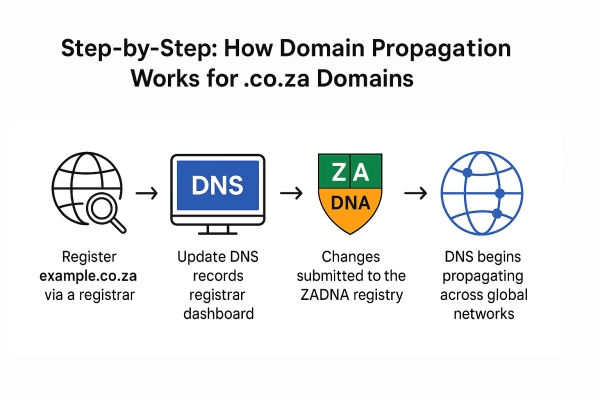
Understanding the Basics of Domain Names
Before diving into how domain propagation works, it’s important to understand the foundation of it all: domain names. Every website begins with a domain name and this is basically your unique address on the internet. This section breaks down what domain names are, how they’re structured (especially in the context of South Africa’s .co.za domain), and why they’re essential for building and navigating the web. Whether you’re a business owner or a curious learner, this is the first step to mastering domain-related technologies.
What is a Domain Name?
A domain name is your digital address on the internet. Just like a home needs a physical address, websites need domain names so people can find them. For example, “telahosting.co.za” is a domain name pointing to a South African website.
Structure of a Domain Name
Domain names typically consist of two parts:
- Second-Level Domain (SLD): This is the main part (e.g., “telahosting” in telahosting.co.za).
- Top-Level Domain (TLD): This is the suffix (e.g., “.co.za”).
So, in a domain like business.co.za, “business” is the SLD, and “.co.za” is the country-code TLD for South Africa.
Introduction to ccTLDs – The Case of .co.za
What is a ccTLD?
A country code top-level domain (ccTLD) is a domain extension designated to a specific country. Examples include:
- .co.za for South Africa
- .ng for Nigeria
- .ca for Canada
Who Manages the .co.za Domain?
The .co.za domain is managed by ZA Central Registry (ZACR). ZACR is responsible for the technical and operational management of the .co.za namespace, ensuring its security, stability, and accessibility in the South African digital space.
Why .co.za Domains Are Important for South Africa
- SEO relevance for local South African search results
- Enhances national identity online
- Helps businesses build trust with South African customers
What is Domain Propagation?
Definition and Core Concepts
Domain propagation is the period it takes for DNS changes (like pointing your .co.za domain to a new server) to update across global internet servers. It’s not instantaneous, as various servers around the world need time to recognise the new DNS settings.
How Domain Propagation Works Behind the Scenes
When you modify DNS settings (like adding a new name server), the update needs to reach:
- Root DNS servers
- Internet Service Providers (ISPs)
- Local DNS resolvers
Until all of these are updated, some users may still be directed to the old version of your site or experience loading errors.
The Role of DNS in Domain Propagation
What is DNS?
DNS (Domain Name System) works like an internet phonebook. It translates domain names like shop.co.za into IP addresses so browsers can access the correct site.
How DNS Affects Propagation Time
DNS servers store data in a “cache.” Until that cache refreshes (determined by the TTL value), changes won’t show. This is why propagation can take from a few hours to a couple of days.
Step-by-Step: How Domain Propagation Works for .co.za Domains

Registering a .co.za Domain
You can register a .co.za domain through accredited registrars such as telaHosting, 1-Grid, or Domains.co.za.
DNS Record Changes and Update Flow
- Update DNS records via your registrar dashboard.
- Changes are submitted to the ZACR registry.
- DNS changes begin propagating across global DNS networks.
Global Propagation
Even though your .co.za domain is South African, changes must update globally. South African ISPs may update faster than overseas servers.
How Long Does Domain Propagation Take?
Typical Timeline
- 4–8 hours for many .co.za domains
- Up to 48 hours worldwide
Factors Affecting Propagation Speed
- TTL settings
- Registrar responsiveness
- DNS provider quality
- Your ISP’s cache refresh rate
Common Issues During Propagation
Delayed DNS Updates
Some ISPs may update slower than others, causing inconsistency in access across regions.
Cached Data
Browsers and operating systems may store old DNS data, making it appear as if changes haven’t taken effect.
Regional Differences
Someone in Cape Town may see your updated site, while someone in Durban or London may still see the old version.
Tools to Check Domain Propagation Status
Best Free Tools
- WhatsMyDNS.net
- DNSChecker.org
- ViewDNS.info
Just enter your .co.za domain and select the record type to view the current propagation status across the globe.
Best Practices to Minimize Propagation Time
Lower Your TTL
Set TTL to around 300 seconds (5 minutes) before making DNS changes.
Use Reliable DNS Providers
DNS providers like Cloudflare or Google DNS offer faster propagation due to their global infrastructure.
Clear Your Local DNS Cache
- Windows:
ipconfig /flushdns - Mac:
sudo killall -HUP mDNSResponder
Propagation vs Domain Resolution
Key Differences
- Propagation: Time taken for DNS updates to spread
- Resolution: The DNS lookup that finds your server IP
Common Misconceptions
Your domain might seem “down” during propagation, but it’s just still updating in parts of the world.
DNS Records Involved in Propagation
| Record | Purpose |
|---|---|
| A | Points domain to IP address |
| CNAME | Alias of another domain |
| MX | Email delivery |
| TXT | Verification records (SPF, DKIM) |
| NS | Authoritative name servers |
Real-Life Case Study: A .co.za Domain Going Live
- Day 1: Registered mysite.co.za
- Day 1: Updated DNS using Cloudflare
- Hour 2: Live in Johannesburg
- Hour 6: Live in Europe
- Hour 20: Fully propagated globally
Performance Metrics
- 99.9% uptime
- Global load time under 1.2s
- SEO indexing completed within 48 hours
Tips for Businesses Using .co.za Domains
SEO Benefits
Search engines give preference to .co.za domains for users in South Africa.
Trust and Local Identity
.co.za domains signal authenticity and local presence to South African customers.
FAQs About Domain Propagation
1. What is domain propagation?
The time it takes for DNS changes to fully update worldwide.
2. Why is it not instant?
Because DNS information is cached across multiple systems and they refresh at different rates.
3. How can I check if my .co.za domain has propagated?
Use tools like WhatsMyDNS.net.
4. Can I speed up propagation?
Yes, by lowering your TTL before making updates.
5. Will email services be affected?
Yes, if you change MX records, you may experience email delays during propagation.
6. Is propagation different for .co.za and .com?
Technically no, but the registry infrastructure and local ISP behaviours may impact timing slightly.
Conclusion – Making the Most of Your .co.za Domain
Understanding domain propagation is essential for managing any website, especially one using a .co.za domain. While it can’t be skipped, you can minimise downtime with smart practices. Stay informed, and your South African web presence will stay sharp and reliable.